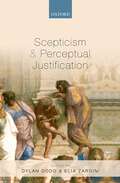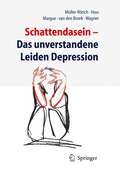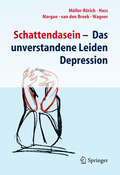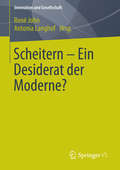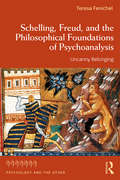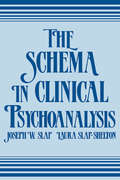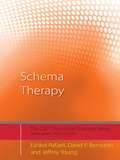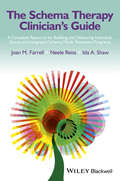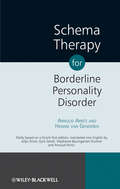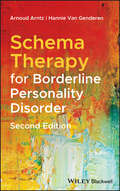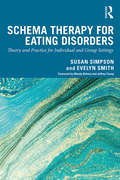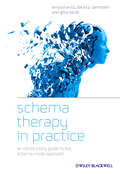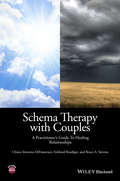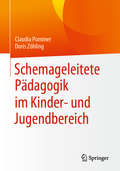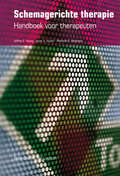- Table View
- List View
Scepticism And Perceptual Justification
by Dylan Dodd Elia ZardiniOne of the hardest problems in the history of Western philosophy has been to explain whether and how experience can provide knowledge (or even justification for belief) about the objective world outside the experiencer's mind. A prominent brand of scepticism has precisely denied that experience can provide such knowledge. How, for instance (these sceptics ask) can I know that my experiences are not produced in me by a powerful demon (or, in a modern twist on that traditional Cartesian scenario, by a supercomputer)? This volume, originating from the research project on Basic Knowledge recently concluded at the Northern Institute of Philosophy, presents new essays on scepticism about the senses written by some of the most prominent contemporary epistemologists. They approach the sceptical challenge by discussing such topics as the conditions for perceptual justification, the existence of a non-evidential kind of warrant and the extent of one's evidence, the epistemology of inference, the relations between justification, probability and certainty, the relevance of subjective appearances to the epistemology of perception, the role that broadly pragmatic considerations play in epistemic justification, the contents of perception, and the function of attention. In all these cases, the papers show how philosophical progress on foundational issues can improve our understanding of and possibly afford a solution to a historically prominent problem like scepticism.
Schacter's cognitive labelling theory (Large Print)
by Rnib BookshareThis image is a flow chart which reads from left to right and bottom to top with four boxes and six arrows. There is a locator dot shown, which will be at the top left of the page when the image is the right way up. This image shows a box on the left representing the stimulus with two arrows on the right, one pointing diagonally up to a box cognitive appraisal of arousal, and the other down to a box physiological changes. This box has a labelled arrow extending vertically upwards via the thalamus sending impulses to the cortex to the top box. The boxes cognitive appraisal of arousal and physiological changes have arrows pointing to a fourth box on the right subjective experience of emotion.
Schattendasein: Das unverstandene Leiden Depression
by T. Müller-Rörich K. Hass F. Margue Annekäthi van den Broek R. WagnerSchattendasein: Anders als bei anderen Krankheiten wagen es depressive Menschen häufig nicht, über ihre Erkrankung zu sprechen. Unterstützung und Austausch finden sie seit einigen Jahren im Internetforum des "Kompetenznetz Depression, Suizidalität". Vier Betroffene und eine Angehörige sichteten nun die Postings des Forums, kommentierten sie und verdichteten sie zu einem Ratgeber – fachlich betreut von Ärzten des Kompetenznetzes Depression. Sie führen zahlreiche Informationen auf: von der Frage wie sich Depression äußert über mögliche Therapien, die Rolle des sozialen Umfeldes bis hin zur Gesundung. Ein vielstimmiges und zugleich fundiertes Bild.
Schattendasein: Das unverstandene Leiden Depression
by Thomas Müller-Rörich Kirsten Hass Françoise Margue Annekäthi van den Broek Rita WagnerMenschen mit Depression können oft über ihre Erkrankung nicht sprechen, nutzen aber das Internetforum des Kompetenznetzes Depression, Suizidalität. Vier Betroffene und eine Angehörige haben für diesen Ratgeber die Einträge gesichtet und kommentiert – fachlich betreut von Ärzten des Kompetenznetzes. Erläutert werden die wichtigsten Fragen, die sich Betroffene stellen: Wie äußert sich eine Depression? Welche Therapien gibt es? Welche Rolle spielt das soziale Umfeld? Für Betroffene, aber auch für Fachleute, die die „Innenansicht“ interessiert.
Scheitern - Ein Desiderat der Moderne? (Innovation und Gesellschaft)
by René John Antonia LanghofDas Phänomen „Scheiterns“ findet man auf der Schattenseite der Gesellschaft. Ist es dann schon verständlich, dass dessen begriffliche Bestimmung und empirische Beschreibung durch die Sozialwissenschaften nur unzureichend ausfällt? Bis auf die organisationstheoretischen Bemühungen macht die Diskussion einen eher ungenügenden Eindruck. Dabei bildet Scheitern unvermeidlich die negative Folie für den Nachweis erfolgreicher Lösungen. Von daher weist Scheitern eine heimliche Prominenz auf, der sich die Sozialwissenschaften stellen müssen. Mit dem Buch wird die bisherige Diskussion dazu aufgenommen, fortgeführt und angereichert. Auf diese Weise wird ein weiterer Grundstein für die Etablierung der Perspektive des Scheiterns in den Sozialwissenschaften gelegt, mit dem nicht nur dieses höchst relevante Problem in den wissenschaftlichen Fokus gerückt wird, sondern überhaupt erst brauchbare Erkenntnisse über die Bedingungen der Möglichkeit des Erfolges zu gewinnen sind.
Schelling, Freud, and the Philosophical Foundations of Psychoanalysis: Uncanny Belonging (Psychology and the Other)
by Teresa FenichelSchelling, Freud, and the Philosophical Foundations of Psychoanalysis provides a long-overdue dialogue between two seminal thinkers, Schelling and Freud. Through a sustained reading of the sublime, mythology, the uncanny, and freedom, this book provokes the reader to retrieve and revive the shared roots of philosophy and psychoanalysis. Teresa Fenichel examines the philosophical basis for the concepts of the unconscious and for the nature of human freedom on which psychoanalysis rests. Drawing on the work of German philosopher F. W. J. Schelling, the author explores how his philosophical understanding of human actions, based as it was on the ideas of drives, informed and helped shape Freud’s work. Fenichel also stresses the philosophical weight of Freudian psychoanalysis, specifically in regards to the problem of freedom and argues that psychoanalysis complicates and reinforces Schelling’s basic idea: to know reality we must engage with the world empathetically and intimately. This book also serves as an introduction to Schelling’s thought, arguing that his metaphysics—particularly concerning the primacy of the unconscious and of fantasy—can be read as a therapeutic endeavor. Finally, the book offers a deep rethinking of the action and nature of sublimation through both Freud’s and Schelling’s texts. Fenichel suggests psychoanalytic therapy is self-interpretation—a recognition of our narratives as narratives, without for that reason taking them any less seriously. Schelling, Freud, and the Philosophical Foundations of Psychoanalysis will be of great interest to psychoanalysts and psychoanalytic psychotherapists as well as scholars of philosophy.
Schelling, Freud, and the Philosophical Foundations of Psychoanalysis: Uncanny Belonging (Psychology and the Other)
by Teresa FenichelSchelling, Freud, and the Philosophical Foundations of Psychoanalysis provides a long-overdue dialogue between two seminal thinkers, Schelling and Freud. Through a sustained reading of the sublime, mythology, the uncanny, and freedom, this book provokes the reader to retrieve and revive the shared roots of philosophy and psychoanalysis. Teresa Fenichel examines the philosophical basis for the concepts of the unconscious and for the nature of human freedom on which psychoanalysis rests. Drawing on the work of German philosopher F. W. J. Schelling, the author explores how his philosophical understanding of human actions, based as it was on the ideas of drives, informed and helped shape Freud’s work. Fenichel also stresses the philosophical weight of Freudian psychoanalysis, specifically in regards to the problem of freedom and argues that psychoanalysis complicates and reinforces Schelling’s basic idea: to know reality we must engage with the world empathetically and intimately. This book also serves as an introduction to Schelling’s thought, arguing that his metaphysics—particularly concerning the primacy of the unconscious and of fantasy—can be read as a therapeutic endeavor. Finally, the book offers a deep rethinking of the action and nature of sublimation through both Freud’s and Schelling’s texts. Fenichel suggests psychoanalytic therapy is self-interpretation—a recognition of our narratives as narratives, without for that reason taking them any less seriously. Schelling, Freud, and the Philosophical Foundations of Psychoanalysis will be of great interest to psychoanalysts and psychoanalytic psychotherapists as well as scholars of philosophy.
The Schema in Clinical Psychoanalysis
by Joseph W. Slap Laura Slap-SheltonSlap and Slap-Shelton proffer the schema as the basis of an internally consistent and clinically relevant model of the mind. Wedded to the dynamic and genetic points of view, the schema model accommodates the clinical realities of trauma, repetition, and sublimation while dispensing entirely with the abstract concepts of traditional metapsychology.
The Schema in Clinical Psychoanalysis
by Joseph W. Slap Laura Slap-SheltonSlap and Slap-Shelton proffer the schema as the basis of an internally consistent and clinically relevant model of the mind. Wedded to the dynamic and genetic points of view, the schema model accommodates the clinical realities of trauma, repetition, and sublimation while dispensing entirely with the abstract concepts of traditional metapsychology.
Schema Therapy: Distinctive Features (CBT Distinctive Features)
by Eshkol Rafaeli David P. Bernstein Jeffrey YoungSchema Therapy combines proven cognitive behavioral therapy techniques with elements of interpersonal, experiential, and psychodynamic therapies in order to help people with long-term mental health problems including personality disorders and chronic depression. Schema Therapy suggests that many negative cognitive conditions are based on past experiences, and therefore provides models for challenging and modifying negative thoughts and behaviors in order to provoke change. In this book, Eshkol Rafaeli, David P. Bernstein and Jeffrey Young – pioneers of the Schema Therapy approach – indicate the 30 distinctive features of Schema Therapy, and how the method fits into the broader CBT spectrum. Divided into two parts, Theoretical Points and Practical Points, this book provides a concise introduction for those new to the technique, as well as a discussion of how it differs from the other cognitive behavioral therapies for those experienced in the field.
Schema Therapy: Distinctive Features (CBT Distinctive Features)
by Eshkol Rafaeli David P. Bernstein Jeffrey YoungSchema Therapy combines proven cognitive behavioral therapy techniques with elements of interpersonal, experiential, and psychodynamic therapies in order to help people with long-term mental health problems including personality disorders and chronic depression. Schema Therapy suggests that many negative cognitive conditions are based on past experiences, and therefore provides models for challenging and modifying negative thoughts and behaviors in order to provoke change. In this book, Eshkol Rafaeli, David P. Bernstein and Jeffrey Young – pioneers of the Schema Therapy approach – indicate the 30 distinctive features of Schema Therapy, and how the method fits into the broader CBT spectrum. Divided into two parts, Theoretical Points and Practical Points, this book provides a concise introduction for those new to the technique, as well as a discussion of how it differs from the other cognitive behavioral therapies for those experienced in the field.
The Schema Therapy Clinician's Guide: A Complete Resource for Building and Delivering Individual, Group and Integrated Schema Mode Treatment Programs
by Joan M. Farrell Neele Reiss Ida A. ShawThe Schema Therapy Clinician’s Guide is a complete clinical resource for psychotherapists implementing schema therapy, group schema therapy or a combination of both in a structured, cost-effective way. The authors provide ready-made individual and group sessions with patient hand-outs. A unique resource providing ready-made individual and group schema therapy sessions, linked across schema modes, allowing clinicians to pick and choose what they need or adopt a full integrated individual and group program which can be delivered over a range of treatment lengths from a six week intensive program to a one year outpatient treatment Approaches treatment by targeting maladaptive Schema Modes rather than specific disorders, thus increasing clinical flexibility and ensuring shelf life through changes in diagnostic classification Provides step-by-step instructions and tips for therapists, along with a wealth of unique clinical resources including sample scripts, handouts, session exercises, assignment forms and patient materials Meets the current need for effective clinical treatments that can provide tangible effects on time and on budget
The Schema Therapy Clinician's Guide: A Complete Resource for Building and Delivering Individual, Group and Integrated Schema Mode Treatment Programs
by Joan M. Farrell Neele Reiss Ida A. ShawThe Schema Therapy Clinician’s Guide is a complete clinical resource for psychotherapists implementing schema therapy, group schema therapy or a combination of both in a structured, cost-effective way. The authors provide ready-made individual and group sessions with patient hand-outs. A unique resource providing ready-made individual and group schema therapy sessions, linked across schema modes, allowing clinicians to pick and choose what they need or adopt a full integrated individual and group program which can be delivered over a range of treatment lengths from a six week intensive program to a one year outpatient treatment Approaches treatment by targeting maladaptive Schema Modes rather than specific disorders, thus increasing clinical flexibility and ensuring shelf life through changes in diagnostic classification Provides step-by-step instructions and tips for therapists, along with a wealth of unique clinical resources including sample scripts, handouts, session exercises, assignment forms and patient materials Meets the current need for effective clinical treatments that can provide tangible effects on time and on budget
Schema Therapy for Borderline Personality Disorder
by Arnoud Arntz Hannie van GenderenThe book was first published in Dutch by Uitgeverij Nieuwezijds - this book is an English language translation, translated from the original Dutch Language version by Jolijn Drost. The book offers a conceptual model of BPD, a treatment model and an array of methods and techniques for treating BPD clients. It covers treatment planning, the therapeutic relationships, cognitive and behavioural techniques, specific strategies, behavioural pattern breaking and the termination of therapy. The appendices contain handouts for patients including a biographical diary, forms for homework assignments and problem solving and a positive self statement log.
Schema Therapy for Borderline Personality Disorder
by Arnoud Arntz Hannie van GenderenThe book was first published in Dutch by Uitgeverij Nieuwezijds - this book is an English language translation, translated from the original Dutch Language version by Jolijn Drost. The book offers a conceptual model of BPD, a treatment model and an array of methods and techniques for treating BPD clients. It covers treatment planning, the therapeutic relationships, cognitive and behavioural techniques, specific strategies, behavioural pattern breaking and the termination of therapy. The appendices contain handouts for patients including a biographical diary, forms for homework assignments and problem solving and a positive self statement log.
Schema Therapy for Borderline Personality Disorder
by Arnoud Arntz Hannie van GenderenProvides clear guidance on utilizing Schema Therapy to reduce BPD symptoms and bring about lasting changes in the patient's personality People with Borderline Personality Disorder (BPD) struggle with a range of problems that negatively impact virtually every aspect of their lives, such as constantly changing moods, blurred personal identities, impulsive behaviors, interpersonal problems, and episodes of rage. BPD patients are at high risk of self-harm and substance abuse, with approximately 10% of BPD patients dying from suicide. BPD severely affects the education, employment, personal relationships, and physical and emotional wellbeing of those suffering from the disorder. Schema Therapy (ST), based on cognitive behavioral therapy and techniques derived from experiential therapies, has been shown to achieve substantial personality improvements in BPD patients. Shema Therapy for Borderline Personality Disorder describes the pioneering BPD therapy based on insights from cognitive, behavioral, psychodynamic, humanistic, and developmental theories. Schema Therapy emphasizes the emotional processing of traumatic experiences and the use of the therapeutic relationship to bring about positive change. The text describes ST treatment for BPD in detail, covering the aims and phases of the therapy, treatment planning, cognitive and behavioral methods, specific techniques appropriate to each schema mode, behavioral pattern-breaking, termination of therapy, and more. This authoritative volume: Describes a treatment for patients with Borderline Personality Disorder (BPD) that yields substantial clinical improvement or recovery in most cases Explains the schema mode model of BPD that helps both patients and therapist understand the problems experienced by BPD patients, and that is central in ST for BPD. Explains Schema Therapy (ST) for BPD based on the schema mode model, discussing different treatment methods and techniques geared to specific schema modes Covers the latest developments in the field of ST, such as Group Schema Therapy and the application of ST for couples. Includes handouts to give to patients, including a biographical diary, forms for homework assignments and problem solving, and a positive self-statement log Schema Therapy for Borderline Personality Disorder is essential reading for clinical psychologists, psychotherapists, psychopathologists, psychiatrists, mental health practitioners, and advanced undergraduate and graduate students in relevant fields.
Schema Therapy for Borderline Personality Disorder
by Arnoud Arntz Hannie van GenderenProvides clear guidance on utilizing Schema Therapy to reduce BPD symptoms and bring about lasting changes in the patient's personality People with Borderline Personality Disorder (BPD) struggle with a range of problems that negatively impact virtually every aspect of their lives, such as constantly changing moods, blurred personal identities, impulsive behaviors, interpersonal problems, and episodes of rage. BPD patients are at high risk of self-harm and substance abuse, with approximately 10% of BPD patients dying from suicide. BPD severely affects the education, employment, personal relationships, and physical and emotional wellbeing of those suffering from the disorder. Schema Therapy (ST), based on cognitive behavioral therapy and techniques derived from experiential therapies, has been shown to achieve substantial personality improvements in BPD patients. Shema Therapy for Borderline Personality Disorder describes the pioneering BPD therapy based on insights from cognitive, behavioral, psychodynamic, humanistic, and developmental theories. Schema Therapy emphasizes the emotional processing of traumatic experiences and the use of the therapeutic relationship to bring about positive change. The text describes ST treatment for BPD in detail, covering the aims and phases of the therapy, treatment planning, cognitive and behavioral methods, specific techniques appropriate to each schema mode, behavioral pattern-breaking, termination of therapy, and more. This authoritative volume: Describes a treatment for patients with Borderline Personality Disorder (BPD) that yields substantial clinical improvement or recovery in most cases Explains the schema mode model of BPD that helps both patients and therapist understand the problems experienced by BPD patients, and that is central in ST for BPD. Explains Schema Therapy (ST) for BPD based on the schema mode model, discussing different treatment methods and techniques geared to specific schema modes Covers the latest developments in the field of ST, such as Group Schema Therapy and the application of ST for couples. Includes handouts to give to patients, including a biographical diary, forms for homework assignments and problem solving, and a positive self-statement log Schema Therapy for Borderline Personality Disorder is essential reading for clinical psychologists, psychotherapists, psychopathologists, psychiatrists, mental health practitioners, and advanced undergraduate and graduate students in relevant fields.
Schema Therapy for Eating Disorders: Theory and Practice for Individual and Group Settings
by Susan Simpson Evelyn SmithOptions can be limited for those who do not respond to standard eating disorder treatments. Schema therapy is one of the new exciting frontiers in the treatment of this clinical population, offering a much-needed model that integrates both developmental and deeper level personality factors. Schema Therapy for Eating Disorders is the first book of its kind, guiding clinicians to deliver the schema model to those with entrenched or enduring eating pathology, and in turn encouraging further clinical research on this approach to treatment. Written by an international team of leading schema therapy experts, and with a foreword by Wendy Behary and Jeffrey Young, this book draws on their clinical knowledge and research experience. Comprehensive and practical, this book introduces the rapidly growing evidence base for schema therapy, outlines the application of this model across eating disorder diagnostic groups, as well as individual and group modalities, and explores practical considerations, common challenges and the therapeutic process. The book includes detailed case examples, which provide a theoretical and practical basis for working with therapist-client schema chemistry and transference, and outlines methods of ensuring therapist self-care in the face of difficult and often long-term work. Innovative and accessible, this fresh look at the treatment of eating disorders will be an invaluable resource for clinicians in the field.
Schema Therapy for Eating Disorders: Theory and Practice for Individual and Group Settings
by Susan Simpson Evelyn SmithOptions can be limited for those who do not respond to standard eating disorder treatments. Schema therapy is one of the new exciting frontiers in the treatment of this clinical population, offering a much-needed model that integrates both developmental and deeper level personality factors. Schema Therapy for Eating Disorders is the first book of its kind, guiding clinicians to deliver the schema model to those with entrenched or enduring eating pathology, and in turn encouraging further clinical research on this approach to treatment. Written by an international team of leading schema therapy experts, and with a foreword by Wendy Behary and Jeffrey Young, this book draws on their clinical knowledge and research experience. Comprehensive and practical, this book introduces the rapidly growing evidence base for schema therapy, outlines the application of this model across eating disorder diagnostic groups, as well as individual and group modalities, and explores practical considerations, common challenges and the therapeutic process. The book includes detailed case examples, which provide a theoretical and practical basis for working with therapist-client schema chemistry and transference, and outlines methods of ensuring therapist self-care in the face of difficult and often long-term work. Innovative and accessible, this fresh look at the treatment of eating disorders will be an invaluable resource for clinicians in the field.
Schema Therapy in Practice: An Introductory Guide to the Schema Mode Approach
by Arnoud Arntz Gitta JacobSchema Therapy in Practice presents a comprehensive introduction to schema therapy for non-specialist practitioners wishing to incorporate it into their clinical practice. Focuses on the current schema mode model, within which cases can be more easily conceptualized and emotional interventions more smoothly introduced Extends the practice of schema therapy beyond borderline personality disorder to other personality disorders and Axis I disorders such as anxiety, depression and OCD Presented by authors who are world-respected as leaders in the schema therapy field, and have pioneered the development of the schema mode approach
Schema Therapy in Practice: An Introductory Guide to the Schema Mode Approach
by Arnoud Arntz Gitta JacobSchema Therapy in Practice presents a comprehensive introduction to schema therapy for non-specialist practitioners wishing to incorporate it into their clinical practice. Focuses on the current schema mode model, within which cases can be more easily conceptualized and emotional interventions more smoothly introduced Extends the practice of schema therapy beyond borderline personality disorder to other personality disorders and Axis I disorders such as anxiety, depression and OCD Presented by authors who are world-respected as leaders in the schema therapy field, and have pioneered the development of the schema mode approach
Schema Therapy with Couples: A Practitioner's Guide to Healing Relationships
by Chiara Simeone-DiFrancesco Eckhard Roediger Bruce A. StevensSchema Therapy for Couples represents the first practitioner guide to detail effective Schema Therapy techniques in couple and relationship therapy. Shows how the distinctive features of ST make it ideal for addressing the cognitive and emotion-focused problems typical in couple relationships Presents and integrates a series of innovative tools and interventions such as Schema Therapy with Needs versus Wants, Mode Cycle Clash Cards, limited re-parenting visualization, and chair work Authored by an international team of experts in couples therapy and Schema Therapy
Schema Therapy with Couples: A Practitioner's Guide to Healing Relationships
by Chiara Simeone-DiFrancesco Eckhard Roediger Bruce A. StevensSchema Therapy for Couples represents the first practitioner guide to detail effective Schema Therapy techniques in couple and relationship therapy. Shows how the distinctive features of ST make it ideal for addressing the cognitive and emotion-focused problems typical in couple relationships Presents and integrates a series of innovative tools and interventions such as Schema Therapy with Needs versus Wants, Mode Cycle Clash Cards, limited re-parenting visualization, and chair work Authored by an international team of experts in couples therapy and Schema Therapy
Schemageleitete Pädagogik im Kinder- und Jugendbereich
by Claudia Pommer Doris ZöhlingSchemageleitete Pädagogik ist die konsequente Anwendung des aktuellen Wissensstandes über die Folgen und Symptome von stark belasteten Kinder- und Jugendlichen mit ihren Familiensystemen zur Gestaltung des sozialpädagogischen Alltags. Dabei baut sie eine Brücke von der Schematherapie zur sozial- und heilpädagogischen Praxis in Kindergärten, Schulen und Kinder- und Jugendhilfeeinrichtungen. Für ErzieherInnen, LehrerInnen, SozialpädagogInnen, PsychologInnen und SozialarbeiterInnen dient das Buch als Einführung in dieses innovative Konzept und praktische Handreichung.
Schemagerichte therapie: Handboek voor therapeuten
by J.E. Young J.S. Klosko M.E. WeishaarWanneer disfunctionele denk– en gedragspatronen hardnekkig zijn, liggen er vaak zogeheten "schema"s" aan ten grondslag. Dit zijn belangrijke overtuigingen en gevoelens die het individu aanneemt zonder zich daarover vragen te stellen. Schema"s ontwikkelen zich in de kindertijd en breiden zich daarna uit. Schema"s houden zichzelf in stand en bieden sterke weerstand tegen verandering. Traditionele therapieën blijken dan ook doorgaans te beperkt te zijn om die schema"s omver te werpen.Schemagerichte therapie is een geïntegreerde therapeutische benadering waarin elementen uit cognitieve, gedragstherapeutische en psychodynamische modellen, hechtingsmodellen en gestaltmodellen met elkaar worden gecombineerd. Deze therapie is erop gericht schema"s bij de patiënt te onderkennen en te doorbreken. Het is een effectieve behandeling voor een breed scala van klinische problemen, zelfs bij patiënten die immuun voor behandeling lijken. Dit boek is het eerste uitgebreide werk voor clinici dieschemagerichte therapie in hun praktijk willen toepassen. Het conceptuele model van de therapie wordt op uiterst heldere wijze beschreven. Vervolgens worden er behandelprotocollen gegeven. Het geheel wordt geïllustreerd aan de hand van praktijkvoorbeelden en therapiefragmenten. De auteurs bespreken in deze uitgave niet alleen de behandeling van patiënten met as–I–stoornissen, maar er worden ook recent ontwikkelde protocollen gegeven voor de behandeling van borderline–patiënten en narcistische patiënten.Met dit boek, geschreven door onder anderen de grondlegger van de schemagerichte therapie, Jeffrey Young, beschikken therapeuten eindelijk over een allesomvattende handleiding voor de behandeling van die bijzonder lastige patiënten met chronische, langdurige schema's en patronen.
